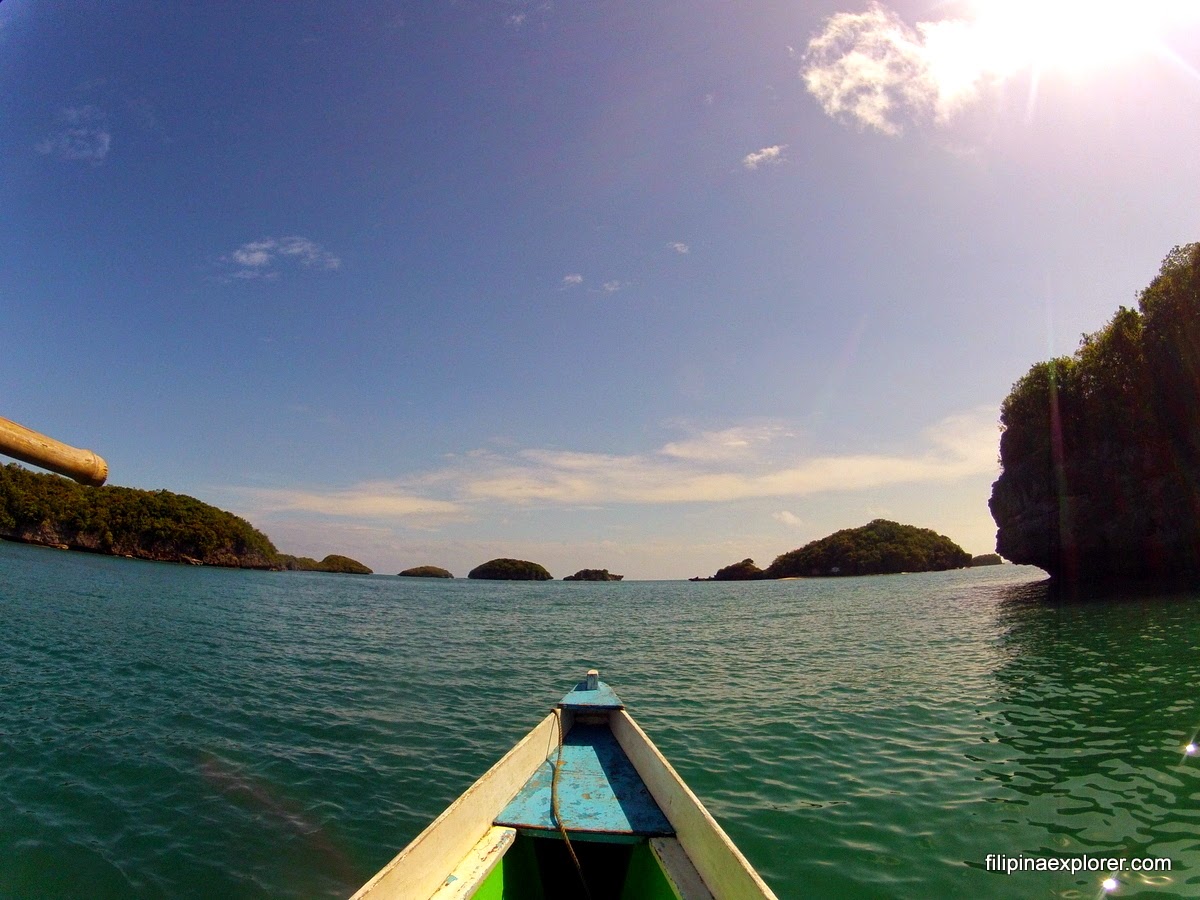At 9 am, Lucap Wharf was inundated with throngs of hungry tourists arranging their trips for Hundred Islands. Vendors hawking native hats greeted us by the entrance with smiles as warm as the midmorning sun, their tenacity never waning despite the countless nos.
Everything, from boat rides down to snorkel gears, has standardized rates and can only be transacted via the tourism desk inside the wharf. It’s streamlined and simplified: choose a tour package, select add-ons, pay, get tickets and map, board a boat.
 |
| Lucap Wharf’s famous lighthouse. |
 |
| View of the islands from Governor Island’s viewdeck. |
“Or,” she continued, “pay P1,400 and you can visit all (23) islands in the loop and stay for as long as you can in any. The boat man is yours,” she said.
I haul P1,400 out of the squalor that is my pouch and jested, “as in forever?”
Docked boats floated on petrol- and weed-littered waters, which is characteristic of the sea surrounding majority of can-be-visited islands. Such sight made the journey less mesmerizing; we psyched ourselves up with a hundred green mounds sewn together on the horizon.
Governor’s Island
We were ferried first to one of the three most visited, highly developed islands after Quezon and Children’s Islands. More than being the largest of all islands in the realm, Governor’s Island is famous for two things: the now-unoccupied one-storey bunk that housed local TV’s PBB teens, and a view deck that affords a bird’s eye view of the 123 islands.
 |
| Veranda of the PBB house. Some of the islands – Virgin Island, most notably – can be seen from up here. |
This, after an exhausting 100 or so uphill steps, or one I’d like to call, that-which-reminds-one-of-Mt.-Tapyas trek. I painfully hoisted up love handles, a two-kilo sling bag, and an 18-kilogram toddler, encountering husbands piggybacking their wives along the way.
That 10-minute challenge was rewarded with an amazing vista of the islands, tails to heads. A turtle, a sandbar that lies beneath green waters, breaks that occur mid-sea, rocks that kiss under the sun.
My cup runneth over with cheesy thoughts somewhere along the lines of, “this is my country, and I’m so proud of it.”
Virgin Island
If you aren’t as adventurous as this guy here, you can tread Virgin Island from the back side of Governor’s Island on foot during low tide.
 |
| Back part of Governor’s Island that serves as start-off point for treks to Virgin Island. |
The island is connected to Governor’s via a sandbar, although the mid-sea breaks can get pretty strong as noon commences, and water rises up to a little above the knee. Aqua shoes are recommended; sharp corals and rocks line some portions of the seabed.
Romulo Island
This wasn’t part of the boatman’s itinerary, but we asked. And I’m so glad we did, because Romulo Island turned out to be my favorite out of all the ones we visited.
Romulo Island’s shore is may be short, but it’s near white, soft and powdery, sinking your feet as you inch further to the edges. It’s understandable how some people bypass it due to its size but if you like pretty islands away from tourist crowds, then Romulo Island is a keeper.
Quezon Island (Giant Clam Farm)
We didn’t specifically go to Quezon Island, because of the P200 “compulsory” fee for huts – as per our boat man – which we later found out, was actually optional. Instead, we docked halfway between Macapagal Island and Quezon Island and went for the next best thing: snorkeled one of three giant clam farms.

Actually, I was the only one who snorkeled. Jigs stayed in the boat with Lia, because he felt it was too risky to snorkel in the middle of the ocean in that tide and depth.
It isn’t actually. Despite the strong current, there’s a guiding rope to hang on to, which intersects Macapagal and Sison Islands (north); and the Giant Clam Farm (east to west). If you have a baby on board, you can alternate babysitting with company. Afterall, exploring the whole farm takes no longer than 30 minutes.
 |
| Macapagal Island – a snorkeling site – as viewed from the giant clam farm site. To the left is Sison Island, which can be reached by swimming, also using a guiding rope. Boats aren’t permitted beyond the red jump-off board to prevent destruction of corals and clams. |
Appreciating the feet-long clams – a conservation effort by UP – though can be challenge: the water is murky, and if you ever make out whatever clam image you can from the silt and murk, it’s too vague even for a person with 20/20 vision.
Children’s Island
 |
| This was her favorite activity there: picking up the weeds. |
Cuenco Tunnel
And then, there were the other islands…
 |
| Part of Monkey island, where purportedly, there are a lot of, uhm, monkeys. |
 |
| Bat Island |
 |
| Clave Island offers a beach, an arc-shaped rock (that kind of doubles as a cave), and a statue of a lion. |
Despite its popularity, Hundred Islands has never been on top of my bucketlist. I had no intentions nor inkling to go there in the next five years, simply because it’s so tourist-hot I find the mystery waning.
And this, kids, is where I say, research REALLY would’ve made the difference.
 |
| Updated standard 2014 rates for Hundred Island tours. The loop on the map illustrates the 23 islands you can visit if you choose the service-type tour. Regular tours are cheaper, but only involve 3 islands: Quezon, Children’s, and Governor’s. |
We were assigned a newbie boat guide for the tour who either didn’t want to go to certain islands because the “waves are too rough”, or just skipped telling us about them altogether. Jigs and I mostly relied on him to take us wherever, hence this rather short list.
Judging on Josiah of Lakas.PH’s table here, it was doable to see at least 10 islands out of 23 navigable ones. We managed to experience a measly six out of a staggering 123. Oy vey.
If only we had the right guide. More importantly, the right minds to be guided by a guide.
But the beauty of residing in a country of 7,107 islands is that if you’re unsatisfied with a few, you’ve 7,000 more options to check.
No oy vey 🙂





















